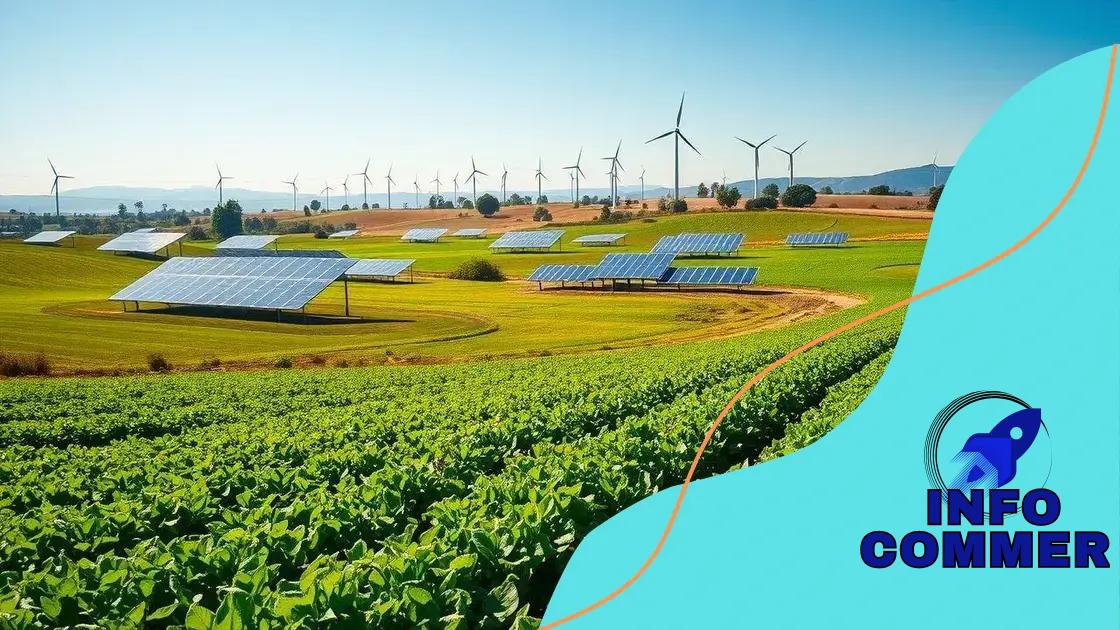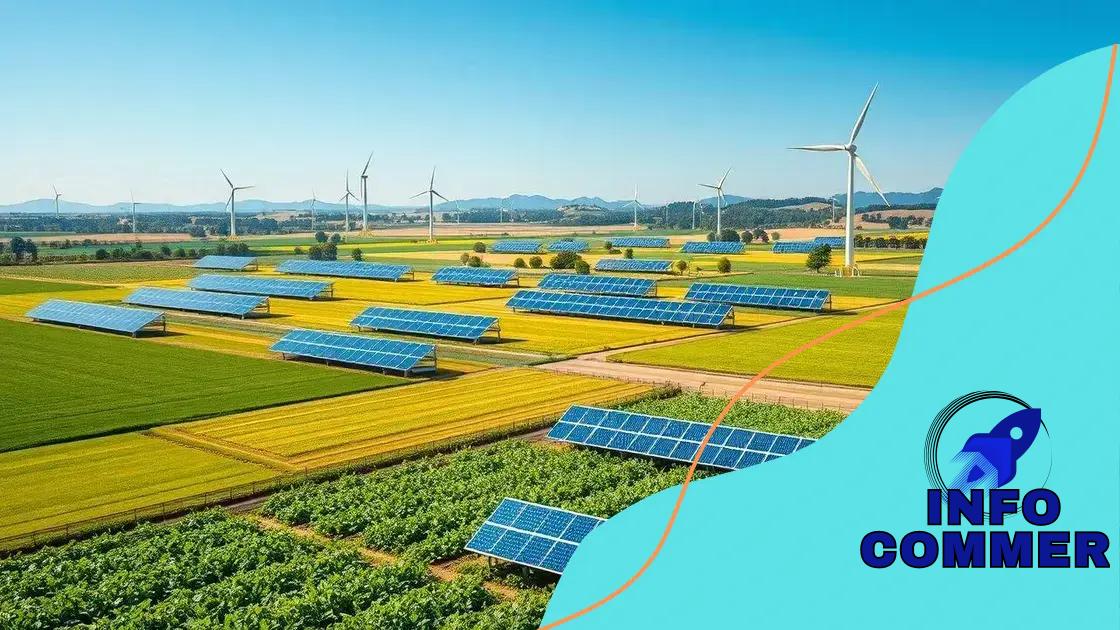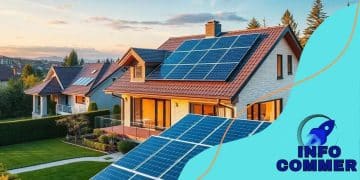Green tech innovations for sustainable farming

Implementing green tech in your farm involves using renewable energy, upgrading irrigation systems, and adopting composting practices to enhance sustainability and reduce environmental impact.
Green tech innovations for sustainable farming are changing the way we cultivate our crops and interact with the environment. Have you ever wondered how these advancements can not only boost yields but also protect our planet? In this article, we’ll dive into the latest technologies and their impact on modern agriculture.
Understanding green tech in agriculture
Understanding green tech in agriculture is essential for creating sustainable farming practices that benefit both the environment and food production. As we face climate challenges, these technologies offer solutions that help farmers adapt and thrive.
One key aspect of green tech is improving energy efficiency. By using smart irrigation systems, farmers can minimize water waste while ensuring their crops receive the right amount of moisture. This is vital in areas where water resources are limited.
Innovative Tools and Techniques
Farmers are turning to various innovative tools that help them reduce their carbon footprint. Precision farming technology, for example, allows farmers to make data-driven decisions based on soil health and weather conditions. This results in less pesticide and fertilizer use, leading to healthier crops and a cleaner environment.
Benefits of Renewable Energy
Incorporating renewable energy sources, such as solar and wind, is another key component of green tech. These energies help power farms, reducing reliance on fossil fuels. This not only cuts costs in the long run but also plays a major role in combating greenhouse gas emissions.
- Reduced pollution from traditional farming methods
- Greater resilience against changing climate conditions
- Lower operational costs over time
As technology continues to evolve, we can expect even more advancements in green tech. The integration of artificial intelligence and machine learning in farming practices is becoming increasingly common, enabling more accurate predictions and efficient use of resources.
Farmers now have access to tools that allow them to monitor crop health, soil conditions, and weather patterns in real time, enabling quicker responses to potential issues. This not only improves productivity but also ensures that farms remain sustainable in the long term.
Innovative sustainable farming techniques
Innovative sustainable farming techniques are transforming the agricultural landscape. These methods not only maximize crop yields but also protect the environment, making agriculture more sustainable.
One popular technique is crop rotation. By changing the type of crops grown in a specific area each season, farmers can improve soil health and reduce pests. This natural method minimizes the need for chemical pesticides and fertilizers.
Aquaponics and Hydroponics
Aquaponics and hydroponics are cutting-edge systems that grow plants without soil. In aquaponics, fish and plants are grown together in a symbiotic environment. The fish waste provides nutrients for the plants, and the plants help filter the water for the fish.
Hydroponics involves growing plants in nutrient-rich water instead of soil. This technique uses less water than traditional farming and can be done indoors or in urban areas where space is limited.
Companion Planting
- Companion planting helps deter pests naturally.
- This technique increases biodiversity on the farm.
- Certain plants can enhance each other’s growth.
Another innovative approach is companion planting. This method pairs different plants that benefit each other when grown nearby. It helps reduce the need for synthetic fertilizers while promoting healthy growth. For example, planting tomatoes alongside basil can improve flavor and repel pests.
Additionally, integrating technology into farming practices is a game-changer. Using sensors and data analytics, farmers can monitor soil health and moisture levels in real time. This information allows them to optimize resource use, ensuring that crops get exactly what they need.
The role of renewable energy in farming

The role of renewable energy in farming is becoming increasingly vital. Farmers are embracing clean energy sources to enhance sustainability and reduce their carbon footprint. By using renewable energy, they can lower operational costs and improve overall efficiency.
Solar panels are one of the most popular forms of renewable energy on farms. They provide an excellent way to harness the sun’s energy for various farm activities. Whether powering irrigation systems or cooling storage facilities, solar energy reduces dependence on non-renewable resources.
Wind Energy in Agriculture
Wind turbines are another powerful tool for farmers. These turbines generate electricity from wind, which can be used on the farm or sold back to the grid. Wind energy can complement solar power, ensuring a steady energy supply throughout the year.
Benefits of Renewable Energy
- Reduces energy costs in the long term.
- Decreases greenhouse gas emissions.
- Provides energy independence for farmers.
Many farms are also exploring the potential of bioenergy. This involves using organic materials, like crop residues and manure, to generate power. Not only does it help in waste management, but it also creates a sustainable energy source that can be used on-site.
Additionally, integrating energy storage solutions, such as batteries, allows farms to utilize renewable energy more effectively. Farms can store energy produced during peak production times and use it when needed, ensuring a reliable power supply at all times.
As technology advances, the implementation of renewable energy solutions is becoming more accessible. Many farmers are now receiving support and incentives from governments to invest in renewable technologies. These initiatives encourage a shift towards greener farming practices.
Case studies of successful green tech farms
Case studies of successful green tech farms offer valuable insights into how innovative practices can lead to sustainability and efficiency. Farmers around the world are adopting various technologies that enhance productivity while protecting the environment.
One notable example is a farm in California that uses drip irrigation systems combined with solar panels. This approach has significantly reduced water waste and energy costs. As a result, the farm not only produces organic fruits and vegetables but also sells excess energy back to the grid.
Vertical Farming Innovations
Another success story comes from a vertical farm located in New York City. This urban farm utilizes hydroponic systems to grow vegetables indoors. By using LED lights and controlled environments, the farm can produce high yields year-round while minimizing water usage. This method of farming reduces the need for pesticides and transportation since the produce is grown right where it is consumed.
Community Impact
- Local employment opportunities are created.
- Access to fresh produce for city dwellers increases.
- Community education programs on sustainability are offered.
In addition to improving local food systems, green tech farms often participate in community outreach. Many offer workshops to educate the public about sustainable practices and the importance of local food sources. This engagement helps to strengthen community ties while promoting healthy living.
Another excellent example is a farm in the Netherlands that integrates smart technology with traditional farming techniques. Using sensors to monitor crop health and weather conditions allows this farm to optimize water and fertilizer use. The result is healthier crops and a reduced environmental impact.
These farms demonstrate that adopting green technology can lead not only to personal success in agriculture but also contribute positively to local communities and the global environment. As more farmers adopt these practices, the potential for sustainable agriculture continues to grow.
How to implement green tech in your farm
Implementing green tech in your farm is an exciting journey toward sustainability. By adopting innovative practices, you can improve efficiency and reduce your environmental footprint. Let’s explore how to start this transition.
The first step is to assess your current farming practices. Understanding how energy, water, and materials flow on your farm is crucial. Identify areas where inefficiencies exist or where you can integrate sustainable technologies. From there, you can prioritize which technologies to adopt based on your needs and budget.
Start with Renewable Energy
A great way to begin is by incorporating renewable energy sources. Solar panels and wind turbines can provide clean energy for your farm’s operations. Calculate your energy needs to determine the appropriate size and type of renewable energy system that suits your operations.
Upgrade Irrigation Systems
- Install drip irrigation to minimize water waste.
- Use weather data to optimize irrigation schedules.
- Consider rainwater harvesting systems for irrigation.
Next, upgrading your irrigation system is essential. Implementing drip irrigation can reduce water use significantly while ensuring your crops receive adequate moisture. Additionally, utilizing weather data allows you to plan when to irrigate based on rainfall forecasts, enhancing water conservation.
Furthermore, consider setting up a composting system. Composting not only reduces waste but also enriches your soil with nutrients. This practice can decrease your reliance on chemical fertilizers, promoting healthier crops and a healthier environment.
It’s also important to educate yourself and your team about these technologies. Participating in workshops and training sessions ensures everyone on the farm understands how to utilize and maintain new systems effectively.
Lastly, don’t hesitate to seek assistance from experts or local agricultural extension services. They can provide advice tailored to your specific farm conditions and help you navigate initial challenges during implementation.
FAQ – Frequently Asked Questions about Green Tech in Farming
What are some examples of green tech I can implement on my farm?
You can implement solar panels, drip irrigation systems, and composting methods to enhance sustainability and reduce environmental impact.
How does renewable energy benefit my farming operations?
Renewable energy reduces reliance on fossil fuels, lowers energy costs, and decreases greenhouse gas emissions, making farming more sustainable.
What is drip irrigation and why is it important?
Drip irrigation delivers water directly to the roots of plants, conserving water and ensuring optimal moisture levels for healthier crops.
How can I educate my team about green tech?
You can organize workshops, attend training sessions, and provide resources on sustainable practices and technologies relevant to your farm.





